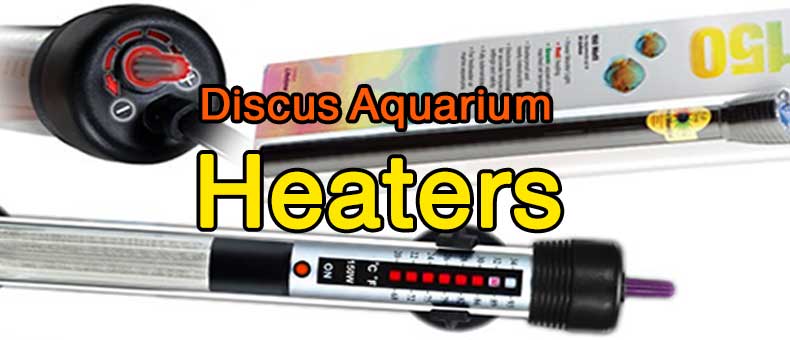
The temperature of your aquarium is crucial to the health of your Discus, and it is difficult to maintain a stable temperature in your aquarium without an aquarium heater.
Table of Contents
- Do Discus Fish Need A Heater?
- Aquarium Heater – Types For Discus Tank
- Heater Types – By Location
- Heater Types – By Materials
- Heater Types – By Placements
- What Is the Best Heater For Discus Tank?
- How Can I Keep My Fish Tank Warm Without A Heater?
- Conclusion
Do Discus Fish Need A Heater?
Discus needs an aquarium heater to stay alive, unlike Mammals, Discus fishes do not have the ability to regulate their own body temperatures. They are dependent on their environment to regulate their body temperature.
These tropical fishes need the Discus aquarium heater for three main reasons:
- To maintain and stabilize the temperature range of the aquarium.
- To increase metabolic activities in the body of the fish.
- To keep disease-causing pathogens away from the aquarium tank etc.
With the right Discus tank heater and temperature, your Discus will hardly bloat.
There are particular heaters suitable for the Discus aquarium tank.
Aquarium Heater – Types For Discus Tank
In choosing an aquarium heater, there are factors to consider; for example, the size of the tank, the location of the tank, etc. There are different types of heaters suitable for your Discus aquarium tank.
We will analyze these types of heaters and how they best suit your aquarium setup, so I will divide aquarium heaters types for you into three main categories:
- Aquarium Heaters – By Location
- Aquarium Heaters – By Materials
- Aquarium Heaters – By Placements
Heater Types – By Location
- External Heaters
- In-Tank Heaters
External Heaters

These aquarium heaters sit outside the aquarium tank.
These external heaters are mostly in-line heaters, and they are installed on the outflow line, heating the water as it flows back into the aquarium tank. External heaters are mostly fat pipes containing a heater element and a built-in temperature that will go off when the previously set temperature is reached.
The Benefits of External Heaters:
[1] – It Is Out Of Sight
An external heater is always unseen, it does not obstruct anything, yet it heats the tank to your desired temperature.
[2] – Save Up The Aquarium Space
It does not take up extra space, and you can still have your perfect aquarium decorations without it being blocked by the heater.
[3] – It Heats The Water Evenly
External heaters warm the aquarium water evenly unlike other heaters like the internal heaters where the water close to the heater is always warmer.
[4] – Easily Maintained
A normal Discus aquarium heater is always unplugged when performing water changes or any of the tank maintenance duties. This is due to the risk of overheating when exposed to air. But with an external heater, you will not need to turn it off.
How to Choose an External Aquarium Heater?
- First, you have to ensure that the heater you are seeing is matchable with your aquarium tank. You don’t want to get a heater that is smaller or bigger than your tank.
- Observe the heater’s ability to be stable at a particular temperature. And if there’s a temperature difference, then it should not be more than 2 degrees.
- Ensure there is overheating protection for overheating, automatic shut off of the heat when it is about to overheat.
- Ensure the heater is compatible with your canister filter.
How To Set Up an External Heater?
The aquarium heater most times comes with an aquarium heater guide, but you still need to be very technical about mastering all the techniques involved.
[1] – Avoid Air Bubbles And Dry Spots
Air bubbles and dry spots can crack the glass the heater, so they must be avoided.
[2] – Get A Heater Controller
Get a Discus tank heater controller to avoid overheating.
[3] – Install External Heater In A Proper Place
Do not install your aquarium heater at the inlet of your filter to avoid junk and debris build up in the heater.
Types of External Heaters
In-Tank Heaters
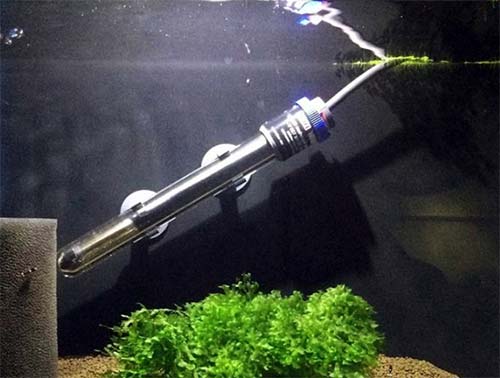
These in-tank heaters may include immersible ad submersible heaters.
They are normally laid inside the aquarium tank to heat the water environment. Some of these heaters can be used to heat up to 80gallon tanks, for example, the orlushy submersible heater.
Benefits of In-tank Heaters
- They are mostly used and efficient for large volume tanks for up to 80gallons.
- Accurate temperature and controls up to 89°F.
- Posses an explosion-proof.
- It can shut off when the maximum heat limit is reached.
- It is easy to set up.
- They are not as expensive as the external heaters.
- They are safer to keep because they are not exposed externally like the external heaters.
Types of In-tank Heaters
How to Choose In-Tank Heaters
You should choose these heaters based on:
- The mass of your tank
- The number of fishes in the tank.
Difference Between External And In-Tank Heaters
- The in-tank heaters are smaller than the external heaters.
- The external heaters are more expensive than in-tank heaters.
- Just as their name implies the external heaters sit outside the tank while the in-tank heaters are inside the tank.
Heater Types – By Materials
- Titanium Heaters
- Glass Heaters
Titanium Heaters

These heaters are very strong and unbreakable material heaters because of its titanium element construct. These material heaters possess a remote sensor that is normally placed away from the titanium heating apparatus. It has a temperature indicator that helps you to adjust and control the temperature properly without dipping your hands in the tank.
A titanium heater is composed of:
- A temperature range of 68F – 92F
- An ultra-tough titanium construct
- An easy-to-read temperature indicator
- A remote sensor for accurate temperatures
- A voltage/Freq: 110V/50-60HH or 220V/50-60HH
Benefits of Titanium Heaters:
- The titanium heater is very strong and lasts longer than all other types of heaters.
- They possess a remote sensor. This helps in checking the temperature.
Types of Titanium Heaters
Glass Heaters

These are heaters made of glass materials; they can be submersible or immersible. Excess heat should be avoided for these heaters because heat can cause it to crack.
Difference Between Titanium And Glass Heaters
- The titanium heater is made up of an ultra-tough titanium construct, so it is tough and long-lasting. The glass heater is not so because of its glass material it can crack with a little excess heat.
- The titanium heater has an easy-to-read temperature indicator, but the glass heater is not so.
- The titanium heater has a remote sensor for accurate temperature, unlike the glass heater.
Precautions When Using Glass Heaters
- Unplug the glass heaters and allow it to cool for a minimum of 30 minutes before removing it from the water.
- After installation, Leave the glass heater for a minimum of 30 minutes before plugging it in.
- Use a drip loop and ensure the cord and plug are dry when plugging your heater in.
Benefits of Glass Heaters
- They are smaller in size and do not take so much space in the aquarium.
- They are very durable if handled carefully.
Types of Glass Heaters
Heater Types – By Placements
- Partially Submersible Heaters
- Submersible Heaters
Partially Submersible Heaters
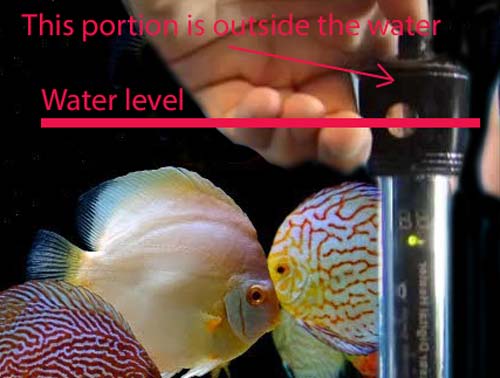
This heater can only provide basic heat for your aquarium. The partially submersible heater is also known as hanging heaters, a hole is bored at the hood of the tank, and the heater is hanged over the top of the aquarium tank.
While the heating element boxed in a glass case is laid inside the tank to heat the water. This heater is normally used in freshwater tanks for beginners and comes with aquarium start-up kits. The heat that this type of heater provides is mostly not enough to go around the tank.
Benefits of a Partially Submersible Heater
- This heater is the best heater for a new aquarium tank so you can easily manage the temperature from its tuning knob since it is outside the water.
- It is cost-effective and durable within a period of 2years if used properly.
Types of Partially Submersible Heaters
Submersible Heater

These heaters sit under the water, and it is placed next to the inlet of the filter so as to heat the water as it comes back into the tank. Submersible heaters possess LED lights at the top, which indicates when the heater is on.
This heater possesses a coiled element in an enclosed glass or thick plastic tube. When the heater overheats the glass, the tube is prone to cracking, the plastic has less chance of cracking. This heater provides a more stable temperature than the immersible heater.
Benefits of Submersible Heater
- It heats the water as it flows into the tank, so as to maintain a steady temperature in the tank.
- It posses an indicator at the top to tells whether the heater is on or not.
Types of Submersible Heaters
What Is the Best Heater For Discus Tank?
The best heater for a Discus tank would be a heater that would provide sufficient, stable heat for the whole tank. The heaters below are the best options for your Discus tank.
[1] – Finnex Titanium Heater with External Thermostat

There is little or no chance of cracking for this type of heater. It is very durable. Unlike the glass heater, the titanium heater will never break. It posses an external thermostat that has alarms to notify you when the temperature is too high or too low; they are perfect for keeping constant temperatures, most times you have to buy it separately.
It is the best heater you can get for your aquarium, and it is very strong and lasts longer, you may check Finnex Titanium Heater with External Thermostat profitable price from Amazon.
[2] – Eheim Jaeger
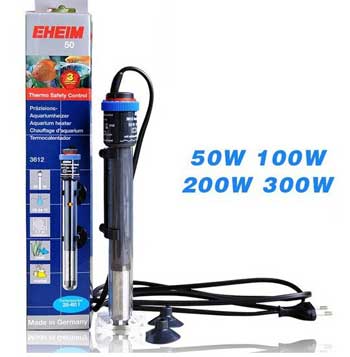
This heater is a glass heater, one of the best you can get. It lasts long, so you can check Eheim Jaeger’s price from Amazon.
[3] – Marineland Visi therm
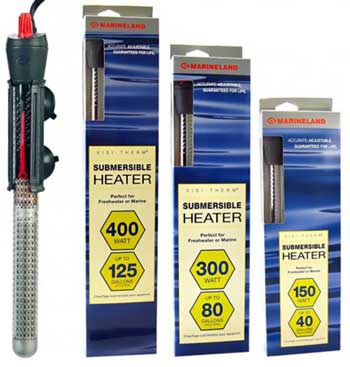
These are glass heaters that come with a rubberized shell, they are strong and also lasts long, the Merinelan Visi therm is also a perfect option for your 50 – 55 gallons Discus tank.
How Can I Keep My Fish Tank Warm Without A Heater?
To keep your Discus tank warm without using a heater you may:
- Cover the tank to prevent heat from escaping.
- Maintain a warm environment inside your house.
- Ensure the temperature inside the house is suitable for your fish, if not make an emergency heater available to help.
Conclusion
A built-in thermostat can fail at any time, as a result of excess heat in the tank. Because the heater will never shut off on its own, it is advisable to spend a little extra to get a titanium finnex heater. It will save you so much more than you spent.
The Discus aquarium heater supplies heat to the aquarium, and this heat provides a comfortable environment for the Discus fish, it increases the metabolic activities of the fish. This enables your fish to digest the food faster, excrete, and then keep eating.

